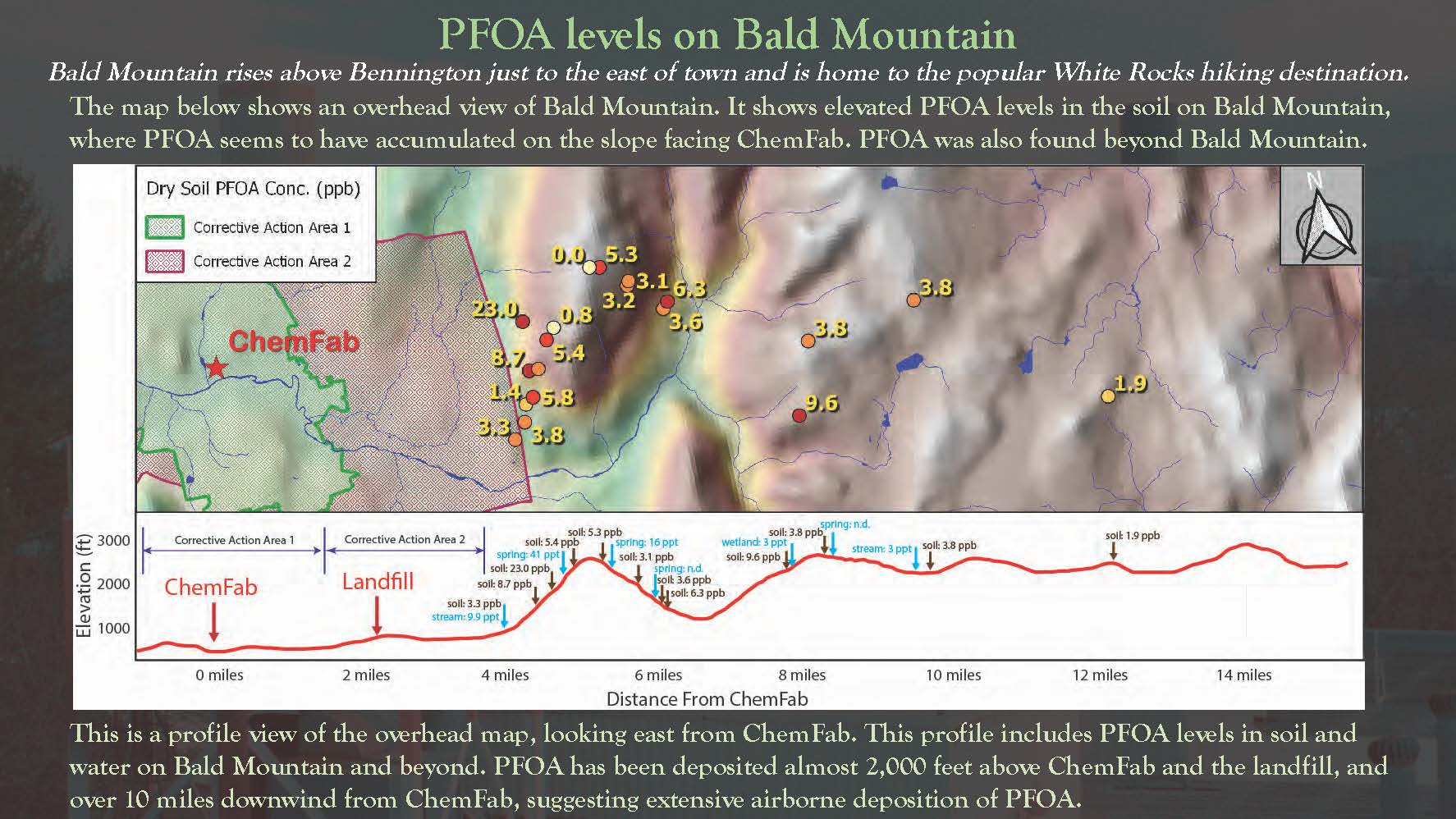
Understanding PFOA
In 2015, local residents reached out to Bennington College to help them understand the alarming discovery of PFOA in their drinking water. With the support of the National Science Foundation, we have been opening our science classrooms to this nearby environmental problem ever since. Whether in teaching public seminars or conducting independent research, our goal is to use the best science to help citizens better understand the problem of PFAS contamination and secure environmental justice today.
Research Results
PFOA in Bennington Region Groundwater (2016-2024): Spatial Patterns and Temporal Trends
(March 17, 2025)
Bennington College partnered with VT DEC to analyze the substantial data the state has amassed on PFOA in the groundwater of southwest Vermont. Faculty and students analyzed PFOA levels in 4,797 groundwater samples from 698 unique wells that were taken from 2016 to 2024. The Bennington College team analyzed this dataset for spatial patterns and temporal trends in PFOA levels.The Bennington College team identified a linear relationship between distance from ChemFab and PFOA levels in groundwater. By and large, the further away from ChemFab the lower the level of PFOA in groundwater. However, there were a number of places where PFOA was detected at levels above and below what the distance from ChemFab would predict. identified a number of spatial patterns to help explain these deviations, including wind direction, bedrock type, slopes facing ChemFab, and proximity to fault lines.These results are consistent with ChemFab being the primary source of PFOA contamination in the Bennington region. We also identified a clear temporal trend in PFOA levels in the Bennington region. PFOA levels are slowly but steadily rising in regional groundwater. While 84 wells show a decline in PFOA levels from 2016-2024, another 239 wells show an increase in PFOA levels during that same time. These findings support the need for robust and comprehensive testing of wells for PFOA in the wider Bennington region.
The Bennington College research team presented their findings to the public in a presentation at the Bennington Firehouse on March 17, 2025.



The Reckless Rush to Incinerate AFFF, 2016-2020 (March 23, 2021)
Since 2016, the US military rushed to incinerate 20 million pounds of Aqueous Fire Fighting Foam (AFFF), a toxic fire-fighting foam linked to a host of cancers, developmental disorders, immune dysfunction, and infertility. There is no evidence that industrial incineration destroys these toxic chemicals. Much of this ill-advised and unproven burning of AFFF happened in environmental justice communities. The American public has been kept in the dark about this reckless effort to burn AFFF.
In 2020, we obtained four documents listing shipments of AFFF to incinerators. Two documents originated with the Defense Department and two originated with New York State Department of Environmental Conservation. Compiling and analyzing these shipments of AFFF helped bring the scale of this environmental justice issue into sharp and urgent focus.
Our full analysis and all of our data can be found at: www.bennington.edu/AFFF.
- Press Release [03.23.21]
- Audio of News Conference [03.23.21]
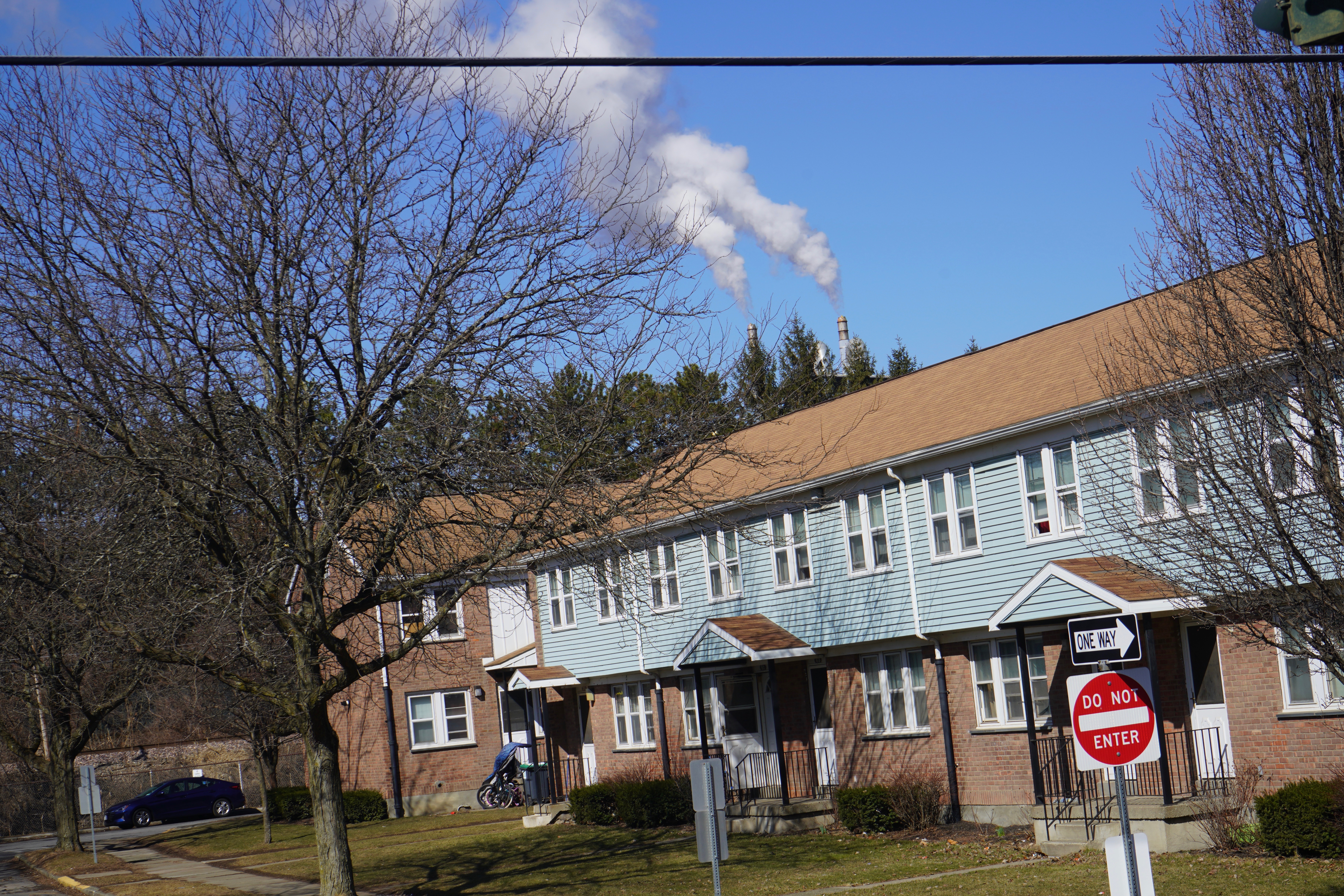
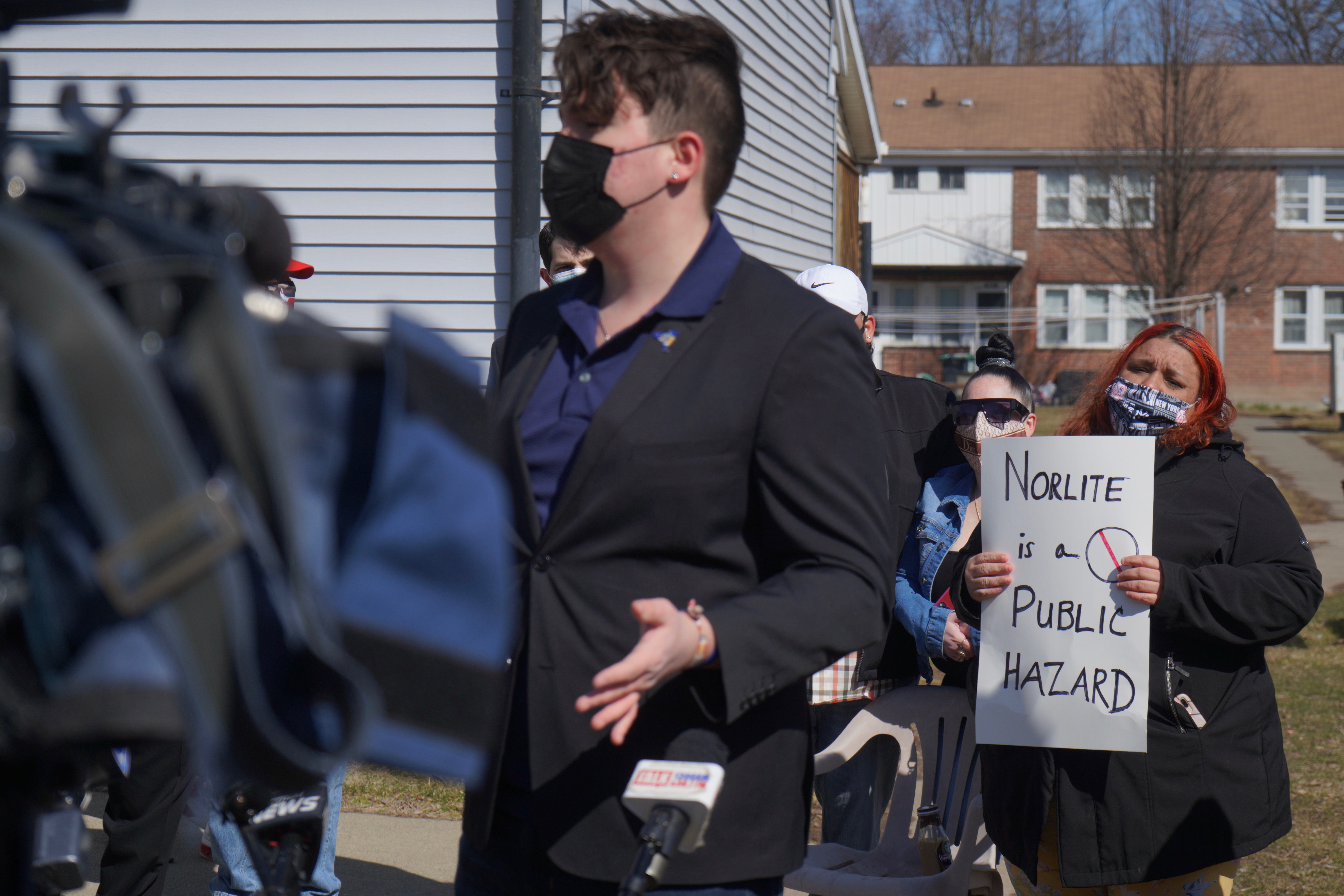
***********************
PFAS Levels in Soil and Water around Norlite Incinerator: Summary of Findings (April 27, 2020)
The Norlite hazardous waste incinerator in Cohoes, NY burned Aqueous Fire Fighting Foam (AFFF) in 2018 and 2019. AFFF is made up of toxic perfluorinated compounds (PFAS) like PFOA and PFOS. There is no evidence that incineration effectively destroys PFAS compounds. Exposure to trace amounts of these chemicals is strongly linked to a host of cancers and other adverse health impacts.
In early March, a team of Bennington College professors and students took soil and surface water samples from the neighborhoods around the Norlite plant. Eurofins commercial laboratory analyzed these samples for a wide array of PFAS compounds.
What we found is concerning. The soil and surface waters around Norlite are laced with PFAS compounds commonly found in AFFF. The results of this preliminary research suggest the burning of AFFF at Norlite is not breaking down these dangerous chemicals so much as redistributing them into nearby poor and working class neighborhoods. Far from destroying the toxins, the Norlite facility appears to be a significant local and potentially regional source of PFAS contamination.
- Press Release and Fact Sheet [04.30.20]
- Map of Sample Sites [04.27.20]
- Full Laboratory Results [04.27.20]
- Audio of News Conference [4.27.20]
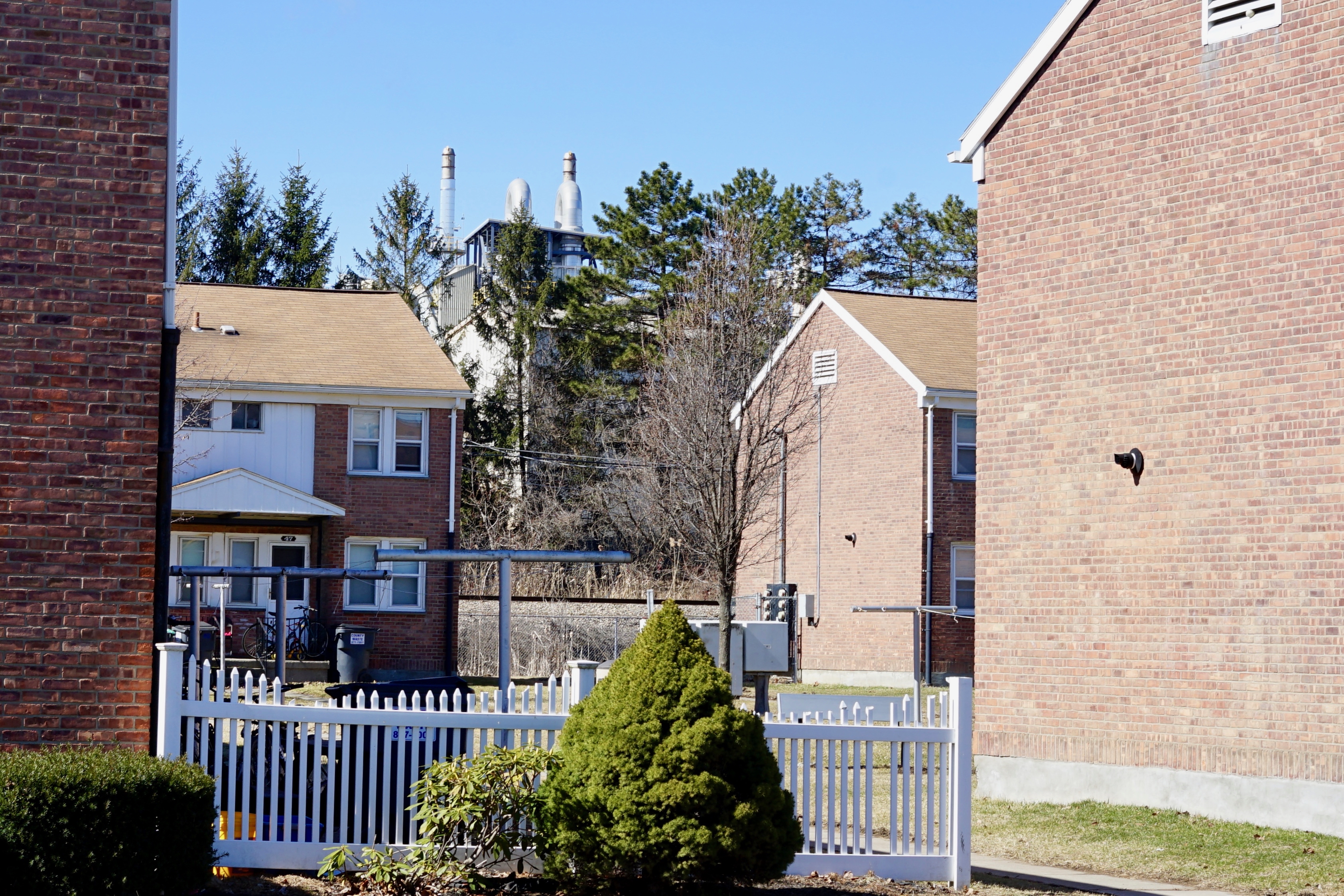
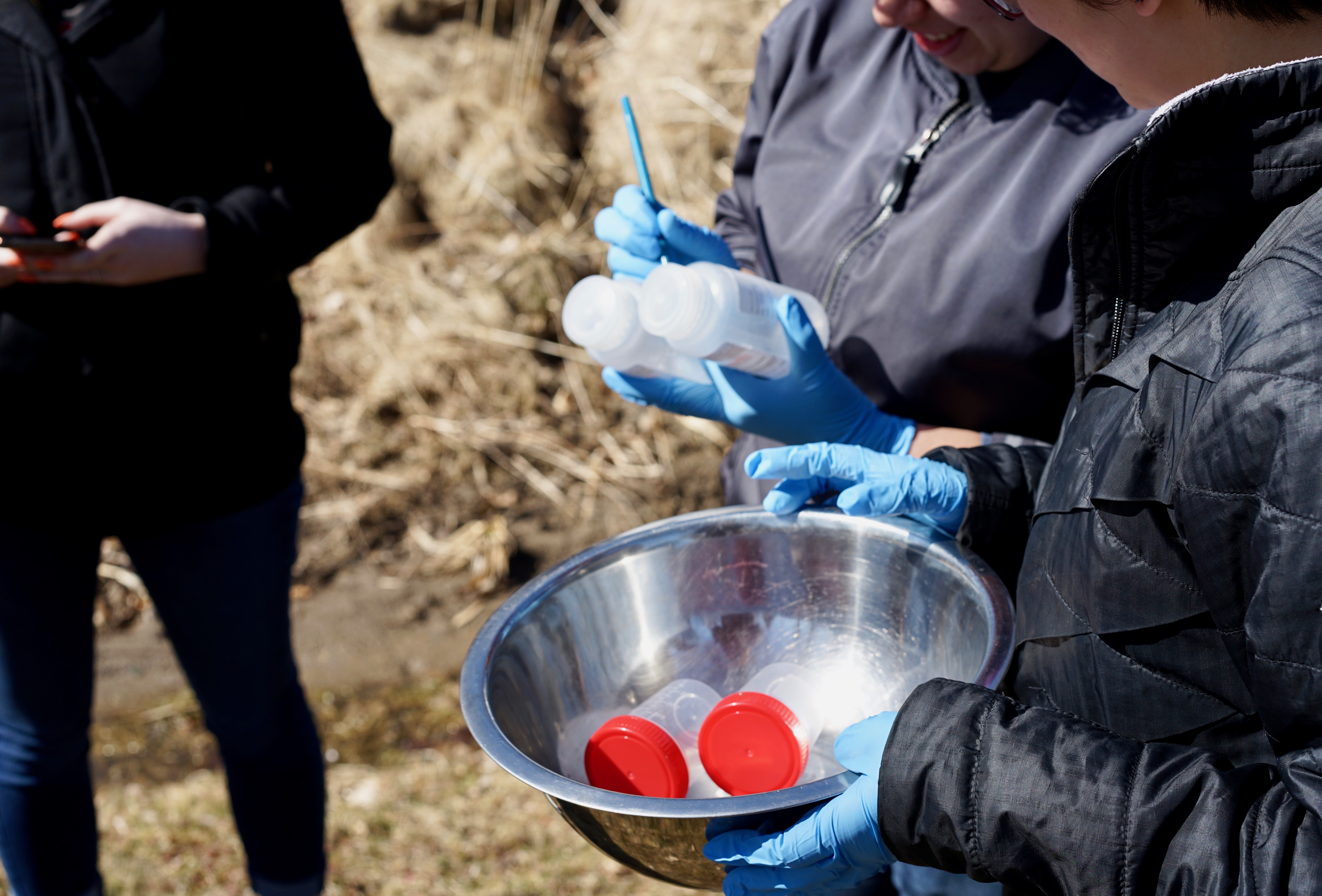
***********************
PFOA Community Health Questionnaire: Summary of Findings (August 21, 2018)
A recent community health questionnaire identified previously unreported cases of cancer and illnesses linked to PFOA exposure in Hoosick Falls and Petersburgh, NY and Bennington, VT. In response to community concerns, a ten-question health questionnaire was distributed to current and former residents of three New York and Vermont communities impacted by PFOA. This questionnaire asked local residents about their own understanding of their health and the health of their family as it relates to six illnesses linked to PFOA exposure.
With 443 responses, this questionnaire reported 31 instances of kidney cancer, 11 instances of testicular cancer, and over 230 instances of thyroid disease in Hoosick Falls, Petersburgh, and Bennington. Hoosick Falls (pop. 3,420) fielded the most participants in this questionnaire, with 373 residents responding. From respondents living in the Village of Hoosick Falls, the questionnaire reported 17 cases of kidney cancer, 9 cases of testicular cancer, and 135 cases of thyroid disease. These numbers stand at odds with previous reports.
The results of this questionnaire gives credence to the health concerns of residents, and their healthcare needs.
- Press Release [08.21.18]
- Fact Sheet [08.21.18]
- David Bond: PFOA Victims Deserve Medical Monitoring, Health Care (Op-Ed in Times Union)
- Copy of Questionnaire
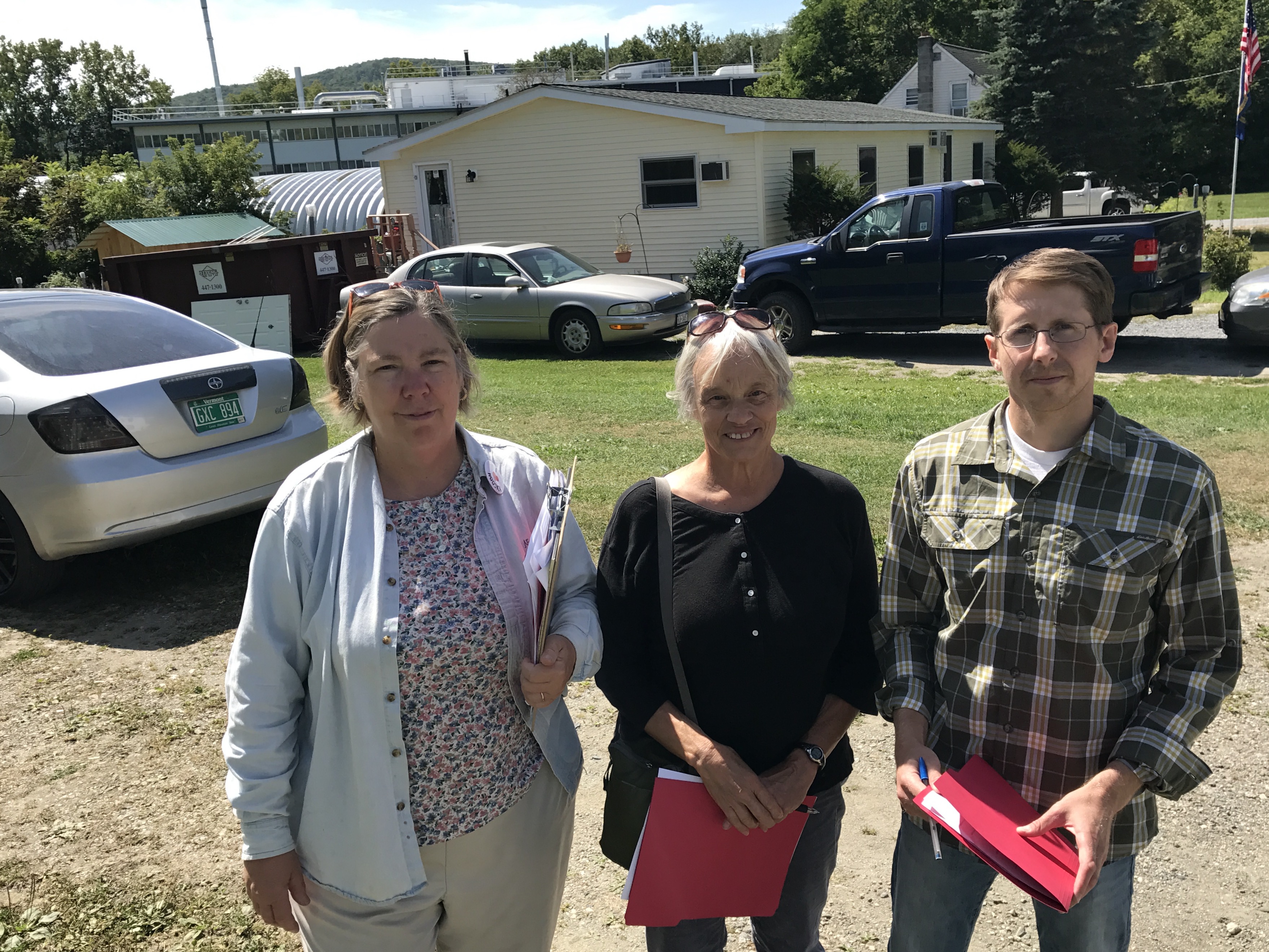
***********************
Regional Soil Study: Summary of Findings (August 1, 2018)
Our research has begun to identify a distinct plume of soil with elevated levels of PFOA that lies directly downwind of the ChemFab facility in North Bennington. Stretching over 10 miles eastward from Bennington into the Green Mountains and covering roughly 120 square miles of southeastern Vermont, this plume of elevated PFOA soil levels suggests extensive airborne deposition of PFOA from the ChemFab facility.
- Tim Schroeder, David Bond, & Janet Foley: PFAS soil and groundwater contamination via industrial airborne emission and land deposition in SW Vermont and Eastern New York State, USA (Environmental Science: Processes and Impacts, 2021)
- David Bond, Janet Foley, & Tim Schroeder: New research suggests more extensive PFOA contamination (Op-Ed in VTDigger)
- Map and Profile of PFOA Soil Levels on Bald Mountain
- Map of Regional PFOA Soil Levels in SE Vermont
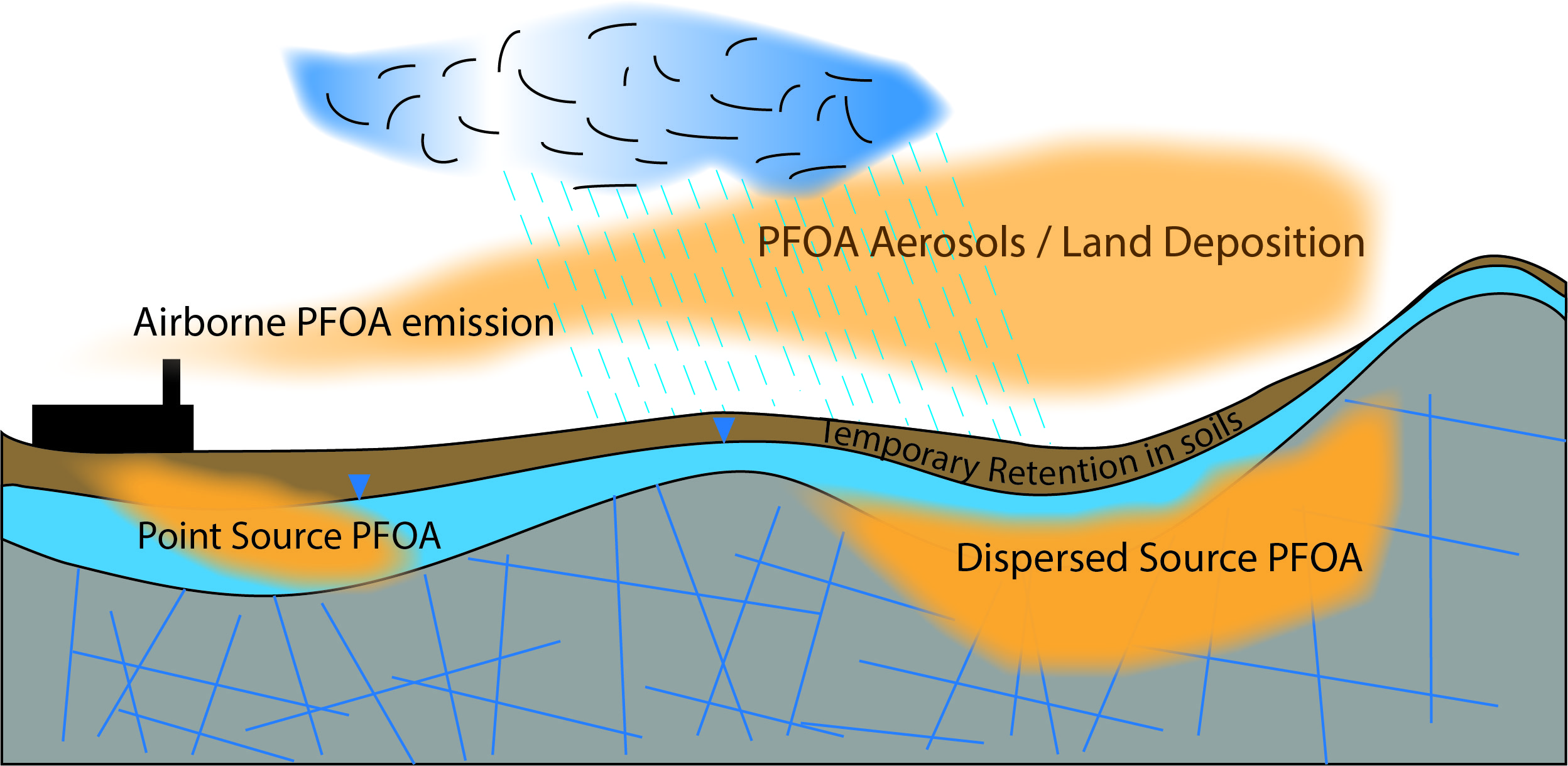
Project Publications
Tim Schroeder, David Bond, and Janet Foley. 2021. “PFAS Soil and Groundwater Contamination Via Industrial Airborne Emission and Land Deposition in SW Vermont and Eastern New York State, USA,” Environmental Science: Processes and Impact, Advance Article (Jan 1).
David Bond. 2020. “Understanding PFOA,” Medical Anthropology Quarterly, Critical Care online series (Nov. 16).
David Bond, Janet Foley, and Tim Schroeder. 2020. “Ban All Incineration of PFAS in New York,” Op-Ed in Albany Times Union (May 30): D2.
David Bond. 2018. “PFOA Victims Deserve Medical Monitoring, Health Care,” Op-Ed in Albany Times Union (Aug 21): A8.
David Bond. 2018. “PFOA Victims Deserve Medical Monitoring,” VT Digger (Aug 26).
David Bond, Janet Foley, and Tim Schroeder. 2018. “New Research Suggests PFOA Contamination Far More Extensive Than Originally Thought,” Op-Ed in Bennington Banner (Aug 2): A6. [reprinted in Vermont Digger]
David Bond and Jorja Rose. 2018. “Saint-Gobain’s Claims Don’t Hold Water,” Op-Ed in Bennington Banner, (May 20): A7 [reprinted in Vermont Digger]
Background
In 2014, the chemical Perfluorooctanoic Acid (C8 or PFOA) was discovered in the public drinking water of Hoosick Falls, NY. As concern over this contaminant grew, other nearby communities began testing their drinking water. As of August 2017, PFOA has been detected in alarming levels in the municipal water supply of three towns in New York and Vermont and in over a thousand private residential wells in the region. (The public water system of North Bennington, where Bennington College gets its water, has tested free of PFOA.)
PFOA was once a key ingredient in the manufacture of high-performance plastics like Teflon and Gore-Tex. Today PFOA and related per- and poly-fluorinated compounds—once celebrated for their inertness—are coming into new focus as an intricate human health risk that operates on the scale of parts per trillion and unfolds over the course of decades. These dimensions, the granular scale of risk, and the extended timeframe of injury, have made PFOA a new kind of problem for environmental science and policy. These concerns have pointed urgency in the impacted communities in our region.
In response to this local environmental crisis, the Center for the Advancement of Public Action (CAPA) at Bennington College has engaged the issue on a number of fronts. David Bond, the associate director of CAPA, along with faculty members Janet Foley and Tim Schroeder, have been awarded two National Science Foundation (NSF) grants to bring the analytical resources of the science classroom into conversation with community concerns about PFOA. As PFOA was first discovered in communities across our region, Bond, Foley, and Schroeder received a $90,000 NSF RAPID Response Grant to offer a new course—“Understanding PFOA”—on the properties, pathways, and policy concerns surrounding PFOA. Alongside Bennington students, this class was opened to high school teachers, nurses, local journalists, and community members from Hoosick Falls and Bennington. This class was offered as a primer on PFOA that could equip students and citizens alike to better navigate the very complicated science of PFOA, to produce data more attuned to local concerns, and to demand better protections for water resources moving forward.
Expanding on these early engagements, in June 2017 Bond, Foley, and Schroeder were awarded a $300,000 NSF Grant that will support additional courses on PFOA, original research on PFOA contamination in our region, and new collaborations with state agencies, local public schools, and regional colleges and universities. This current three-year project will equip the science classroom to answer community concerns about PFOA, and aims to provide a new educational model of the civic value of science education in times of environmental uncertainty.
CAPA has also hosted public meetings to facilitate dialogue between concerned residents and Vermont state officials. Lastly, CAPA and Environmental Studies at Bennington are also sponsoring a lecture series on PFOA that brings leading voices on the science and policy of PFOA to campus for public talks; recent guests include David Andrews, Senior Scientist with the Environmental Working Group; Laura MacManus-Spencer, chemistry professor at Union College; Brendan Lyons, senior investigative reporter at the Albany Times Union; Joyce Donahue, Senior Health Scientist at the EPA, Chris Higgins, associate professor at the Colorado School of Mines, and attorney Robert Bilott, among others.
What is PFOA?
Perfluorooctanoic Acid (PFOA or C8) is a man-made chemical that is persistent, mobile, and toxic. Once a major ingredient in the manufacture of fire-fighting foams and high-performance plastics like Teflon or Gore-Tex, in the 2000s PFOA came under scrutiny as exposure was correlated to adverse health effects, most notable in workers at plants in Alabama and West Virginia and among residents of the Ohio River valley. Ten years ago, the major US producers of PFOA agreed to voluntarily eliminate PFOA by 2015. Despite the phase-out, a substantial amount of PFOA remains in the environment. In 2016, the EPA established a health advisory guideline for PFOA in drinking water of 70 parts per trillion for long-term exposure (70 ppt can be described as a quarter teaspoon in an Olympic-sized pool). A growing number of lawsuits and toxicology studies are providing new insight into PFOA, which is water-soluble, resists photo- and bio-degradation, is chemically stable in water for nearly a century, is readily absorbed into the body when consumed, has a half-life of 2–7 years in the human body, and bio-accumulates in serum, kidneys, and the liver. Recent laboratory and epidemiological studies have strongly correlated exposure to PFOA with a number of adverse health effects, including developmental problems, reproductive harm, and kidney, bladder, and testicular cancer. At a meeting last year, the United Nations began considering a worldwide ban on PFOA. As the EPA summarizes: “the toxicity, mobility, and bioaccumulation” of PFOA poses urgent and difficult questions for safeguarding human heath in areas where PFOA has been released in the environment.
Public Resources on PFOA
Vermont PFOA Resources
- VT Department of Health, “Facts about PFOA Contamination in North Bennington” (2016)
Q and A about PFOA addressing prominent concerns. - VT Department of Environmental Conservation, “North Bennington PFOA Contamination Updates” (2016)
Information clearinghouse for situation in North Bennington, with background on the site (ChemFab), links to federal agencies reports on PFOA, list of EPA certified laboratories for PFOA tests, maps of current sampling area, summary of test results, and the latest press releases.
Federal Assessments of PFOA
- EPA, “Fact Sheet–PFOS and PFOA” (2016)
This document summarizes the state of science around the “toxicity, mobility, and bioaccumulation” of PFOA, reviewing what is currently known about the chemical properties and environmental pathways of PFOA, what risk it poses to human health, what guidelines different states and federal agencies have adopted around PFOA, and what technologies are available to treat PFOA contaminated water. PFOA has been classified as an “emerging contaminant” by the EPA, a classification that works to both acknowledge the probable dangers of a chemical and the lack of enforceable standards to limit its use. PFOA has been under review at the EPA since the late 1990s, with key summaries of studied health risks published in 2003, 2009, 2014, and 2016 (this document). In 2004, the EPA successfully prosecuted DuPont over PFOA; the company documented PFOA contamination in groundwater around its plant and in the blood of local residents but did nothing. The resulting $10.25 million settlement was the largest administrative penalty the EPA has ever received. In 2006, the EPA facilitated a voluntary phase-out of PFOA among the eight leading fluoropolymer manufactures, with a 95% reduction in production by 2010 and a total elimination of PFOA by 2015. The EPA continues to work towards a more robust understanding of the environmental and health risks of PFOA, an understanding that will allow it to take more forceful action to ban or limit PFOA in the United States. - Introduction to environmental health concerns surrounding PFOA.
- Agency for Toxic Substances and Disease Registry (ATSDR), “Toxicological Profile for Perfluoroalkyls” (2015)
Extensive review of existing toxicological data on PFOA.
PFOA and Public Health
- C8 Science Panel (2013)
The C8 Science Panel is one of the largest epidemiological studies of PFOA. The project, which was part of the settlement of a class action lawsuit against DuPont for PFOA contamination, gathered information on and blood samples from 69,000 people who were exposed to PFOA in their drinking water in Ohio and West Virginia. This website summarizes the public health findings of that eight year investigation. - Philippe Grandjean and Richard Clapp, “Changing Interpretation of Human Health Risks from Perfluorinated Compounds” (2014)
- Gloria Post et al., “Perfluorooctanoic Acid (PFOA), An Emerging Drinking Water Contaminant: A Critical Review of Recent Literature” (2012)
- Kyle Steenland et al., “Epidemiological Evidence and Health Effects of Perfluorooctanoic Acid (PFOA)” (2010)
PFOA in the Environment
- Wendy D’Hollander et al., “Perfluorinated Substances in Human Food and Other Sources of Human Exposure” (2010)
- Sebastian Felizeter at al., “Root Uptake and Translocation of Perfluorinated Alkyl Acids by Three Hydroponically Grown Crops” (2014)
- Magali Houde, et al., “Monitoring of Perfluorinated Compounds in Aquatic Biota” (2011)
Other State Guidelines and Resources for PFOA
- Maine (20 ppt)
- Minnesota (300 ppt)
- New Jersey (40 ppt)
- North Carolina (1,000 ppt)
Journalistic Coverage on PFOA
- Mariah Blake, “Welcome to Beautiful Parkersburg, West Virginia: Home to one of the most Brazen Corporate Gambits in U.S. History,” Huffington Post (2015)
- Defending Science, “Perfluorooctanioc Acid: Case Study” (2012)
- Environmental Working Group, “Teflon Chemical Harmful at Smallest Doses” (2015)
- Environmental Working Group, “PFOA and DuPont: A Poisoned Legacy” (2015)
- Green Science Policy Institute, “Consumers’ Guide to Highly Fluorinated Chemicals” (2015)
- Lindsey Konkel, “These Chemicals in Pizza Boxes and Carpeting Last Forever,” National Geographic (2015)
- Sharon Lerner, “Poisoning the Well: Toxic Firefighting Foam has Contaminated U.S. Drinking Water,” The Intercept(2015)
- Eric Lipton and Rachel Abrams, “Commonly Used Chemicals Come Under New Scrutiny,” New York Times (2015)
- Minnesota Public Radio, “Toxic Traces” (2005)
- Nathaniel Rich, “The Lawyer Who Became DuPont’s Worst Nightmare,” New York Times Magazine (2016)
- Ken Ward, “Sustained Outrage,” C8 Blog, Charleston Gazette (2015)
Responses to PFOA in Other Communities
- Parkersburg, WV, “Keep Your Promises DuPont”
- Portsmouth, NH, “Testing for Pease”
Home Water Filtration Systems for PFOA
In 2008, Minnesota conducted tests on point-of-use water filters to measure their ability to reduce perfluorochemicals, including PFOA, in drinking water. Seven filtration systems were found to reduce PFOA levels in drinking water. These devices include:
Activated Carbon Devices
- Aquion Rainsoft Hydrefiner (P-12 9878)
- Culligan RC-EZ-4
- Kinetico MACguard 7500
- Sears Kenmore (Elite 625.385010)
Reverse Osmosis Devices
- Culligan Aqua Cleer
- 3M/CUNO/Water Factory SQC-3 (04-045)
- EcoWater ERO-375E-CP
- GE Smartwater (GXRM10GBL)
- Kinetico Plus Deluxe VX
- Pentair RO 3500-EX w/GS
- Watts (Premier WP-4V)
International Response to PFOA
September 11, 2019: Film, discussion drive home realities of PFAS threat
Clean water advocate Loreen Hackett, of Hoosick Falls, New York, David Bond, of Bennington College, and Eric Peterson, the producing artistic director at Oldcastle Theatre Company, take part in a panel discussion Tuesday after the theater showed a documentary film on PFAS contamination.
Read about it in the Bennington Banner here.
June 25, 2018: Bond Joins Community Voices at EPA Summit on PFOA
On Monday June 25, Hundreds of residents gathered in Exeter, NH, for a two-day summit on perfluorinated compounds like PFOA. Hosted by the EPA, this inaugural summit brought together impacted communities, state agencies, and EPA leaders to discuss the ongoing response to PFOA contamination in New England and beyond.
Associate Director of CAPA David Bond was given the stage to share Bennington's experience with PFOA contamination, including how Bennington College opened the doors of its science classroom to this nearby environmental problem. Bond presented along with invited representatives from other communities roiled in PFOA contamination, including Barnstable, MA; Westfield, MA; Dover, NH; and Merrimack, NH.
May 16, 2018: Bond and Rose draft Op-Ed on PFOA
David Bond and Jorja Rose ’18 co-authored a Bennington Banner editorial examining Saint-Gobain’s controversial PFOA report. Their Op-Ed, entitled “Upon Closer Inspection, Saint-Gobain’s Claims Don’t Hold Water,” took a critical look at a new report from Saint-Gobain that suggested local residents may be responsible for the extensive PFOA contamination in the Bennington region. Their Op-Ed was reprinted in VT Digger.
May 14, 2018: Vermont ANR Community Meeting on PFOA
Bennington College hosted a public meeting on PFOA on Monday, May 14. At this meeting, the Vermont Agency of Natural Resources (ANR) and the Department of Environmental Conservation (DEC) updated the community about ongoing negotiations with Saint Gobain and reviewed the progress of the water line extension project in North Bennington.
Bennington College faculty members David Bond and Janet Foley provided an update on ongoing research they and their students are doing on PFOA in our region.
January 9, 2018: Vermont ANR Community Meeting on PFOA
Bennington College hosted a public meeting on PFOA on Tuesday, January 9. At this meeting, the Vermont Agency of Natural Resources (ANR) and the Department of Environmental Conservation (DEC) updated the community about ongoing negotiations with Saint Gobain and reviewed the progress of the water line extension project in North Bennington.
Bennington College faculty member Tim Schroeder provided an update on ongoing research on PFOA in our region.
September 8, 2017: Bennington Faculty Host PFOA Information Session with Petersburgh, NY Residents
Over forty residents of Petersburgh, NY packed the Town Hall last Friday evening for an information session on PFOA contamination hosted by Bennington Faculty David Bond, Janet Foley, and Tim Schroeder.
Invited by local residents, Bond, Foley, and Schroeder shared relevant findings from their research project “Understanding PFOA,” addressed questions from residents, and explored ways of engaging their research with community concerns. Bennington Faculty were joined by Chemistry Professor Laura Mac-Manus-Spencer of Union College.
Whether in discussing variation in PFOA levels in a single well over the course of a year or in reviewing preliminary findings that suggest the shallow soil in our region may be acting as an unexpectedly large reservoir of PFOA or in responding to concerns about the present emissions of alternative perfluorinated compounds at local facilities, this information session worked to bring unfolding research into PFOA contamination in our region into conversation with resident’s questions and community concerns.
“Unlikely other communities impacted by PFOA in our region, residents of Petersburgh have sometimes struggled to get the attention and resources they deserve. Many residents still have urgent questions about the nature of PFOA contamination and how the community can best protect its water resources going forward,” said David Bond, Associate Director of the Center for the Advancement of Public Action (CAPA) at Bennington College.
While the research project “Understanding PFOA” has been working with individual residents of Petersburgh for the past 15 months, this was the first time the project was able to engage the community. Petersburgh residents were also invited to sit in on a primer class on PFOA that will be offered in the Spring at Bennington College.
“It was a productive event and I hope we can come back in the coming months with better answers to the resident’s really important questions,” Bond said.
May 19–20, 2017: Taconic Mountain Student Water Conference — PFOA
This conference, co-convened by David Bond (Bennington College) and Ken Facin (Hoosick Falls Central School District) and hosted by Bennington College, introduced advanced high school students from our region to the problems and opportunities that define our water resources. Our inaugural conference focused on PFOA.
Full conference schedule and videos of panels can be found here.
April 27, 2017: Vermont ANR Community Meeting on PFOA
Bennington College hosted a public meeting on PFOA on Thursday, April 27th. At this meeting, the Vermont Agency of Natural Resources (ANR) and Department of Environmental Conservation (DEC) updated the community about ongoing negotiations with Saint Gobain and reviewed the state’s current analysis of the nature and scope of PFOA contamination in our region. ANR Secretary Julie Moore applauded the “very active” work of Bennington College in responding to this nearby environmental problem.
Bennington College faculty David Bond and Tim Schroeder also provided an update of their ongoing research into PFOA in our environment.
June 29, 2016: Meeting Held to Update the Community on PFOA Research
On Wednesday, June 29, the Vermont state Department of Environmental Conservation (DEC) hosted a community meeting at Bennington College to discuss the ongoing PFOA issue in the region.
David Bond, the principal investigator and associate director of the Center for the Advancement of Public Action (CAPA), provided an update on the College’s work thus far:
- The College has trained 20 students and 8 community members (including superintendent of Hoosick Falls Central School District and high school teachers) in the chemistry, geology, and policy issues that inform PFOA groundwater contamination.
- The College has collected 50 water samples and analyzing them for perfluorinated compounds like PFOA (22 from North Bennington, 7 from Petersburgh, 6 from Hoosick Falls, and 6 from Eagle Bridge; the samples were taken from 32 residential wells, 15 surface waters, and 2 maple trees).
- The College has hosting a public lecture series bringing national voices on PFOA to our community, with additional notable speakers planned for the fall term.
- The College has put together a public website with scholarly and journalistic resources on PFOA for the community.
Commissioner Schuren, Chuck Schwer of the Division of Waste Management and Prevention, and Richard Spiese, hazardous sites manager for the Vermont Agency of Natural Resources and point person for the efforts in Bennington, North Bennington, and Shaftsbury, praised work of the College, and emphasized how helpful it is to the state to have a local partner working on the issue.
April 1, 2016: Update on the Results of Surface Water Tests for PFOA
Vermont Governor Peter Shumlin released the results of tests for the presence of PFOA in Bennington-area waterways, including the pond on Bennington College's campus. While Bennington College's pond is not used for swimming, fishing, or other in-water recreation, the pond sample showed PFOA concentrations of 79 parts per trillion. This level is well below what state officials consider to be safe for humans and wildlife in surface water. It is also important to note that the College's drinking water is provided by the municipal water source, which has tested clean of PFOA. The state is in the process of conducting soil testing. We will share that information when we receive it. The College will continue to monitor the situation closely.
March 16, 2016: President Silver’s Update on North Bennington Water Situation
We wanted to share news of the North Bennington private well-water situation, which many of you may have heard about in the media.
The New York Times ran a story yesterday on the PFOA found in some private wells in North Bennington and other communities in the Northeast. Importantly, the municipal water supplies for Bennington and North Bennington (the source of water for the entire Bennington College campus and all its off-campus properties) have tested clean; these findings have been confirmed by independent labs testing multiple samples.
The state of Vermont's response has been remarkably rapid and transparent. The Commissioner of the Vermont Department of Environmental Conservation has been in North Bennington every week, and the Governor was on campus last week to meet with local community members. He reiterated his commitment to aggressively addressing this situation. It is also worth noting that the state of Vermont's standards for water purity are very strict and exceed the federal guidelines.
While not directly affected, the College is committed to providing the community with multiple levels of support, including its intellectual resources. Our faculty experts are helping people locally and farther afield understand what is known and what questions to ask about PFOA as this issue becomes relevant to communities across the nation, and the College is hosting public meetings for the community. Last week, the National Science Foundation awarded the College a Rapid Response grant of $90,000 for several faculty members to study PFOA. The grant enables the College to offer a course this spring and fall to students and community members, and for our research to inform affected communities throughout the country. In addition, we continue to field inquiries from local and national media outlets following the announcement of the NSF grant; faculty members David Bond, Janet Foley, Tim Schroeder, and Susan Sgorbati have been enormously responsive and informative as this situation has unfolded.
Feb 25, 2016: President Silver's Update on North Bennington Water Supply
Governor Shumlin reported today on recent testing for potential water contamination in North Bennington: “The public water supply has been tested and is not affected.” The public water supply is the water source for the entire Bennington College campus.
However, the governor also reported that tests of some commercial and individual household wells in the area do show varying levels of the potentially harmful chemical perfluorooctanoic acid (PFOA), which has also been found in Hoosick Falls, NY.
While this situation does not affect the campus directly, we have arranged transportation to two community meetings announced by the governor. Representatives from the Department of Environmental Conservation will be on hand at these meeting to answer questions. To sign up for the shuttle, please contact Austin Bevin in Student Life.
- Friday, February 26, at 4 pm at the North Bennington Firehouse
- Monday, February 29, at 6 pm at the Bennington Fire Facility (Bennington Town Meeting)
In addition, in response to the Hoosick Falls water crisis, faculty are developing a pop-up course for later in the term.
We are following the conversation and developments closely and will continue to update the campus community. For more information, please call 802-249-5324 to speak with Vermont state officials.
Updates
 Vermont DEC Community Meeting on PFOA
Vermont DEC Community Meeting on PFOA The Vermont Department of Environmental Conservation held a meeting of community member and local legislators from Vermont on September 28 in at Bennington College to answer questions from the community, and communicate further information about PFOA as it unfolds.
 Meeting Held to Update the Community on PFOA Information, Research
Meeting Held to Update the Community on PFOA Information, ResearchOn Wednesday, June 29, the Vermont state Department of Environmental Conservation (DEC) hosted a community meeting at Bennington College to discuss the ongoing PFOA issue in the region. David Bond, associate director of CAPA and principal investigator of the College's research on PFOA, provided an update on the work thus far.
 Vermont DEC Hosts Public Meeting at Bennington
Vermont DEC Hosts Public Meeting at BenningtonThe Vermont Department of Environmental Conservation hosted a public meeting at Bennington College with nearby residents of North Bennington, Bennington, and Shaftsbury.
 Bond Speaks About Class On PFOA
Bond Speaks About Class On PFOADavid Bond, associate director of the Center for the Advancement of Public Action, spoke with Vermont Public Radio about a course being taught at Bennington College about PFOA.
 Foley Speaks with NPR about PFOA
Foley Speaks with NPR about PFOAFaculty member Janet Foley recently spoke with NPR about about PFOA. She, David Bond, and Tim Schroeder are teaching a course beginning next week.
